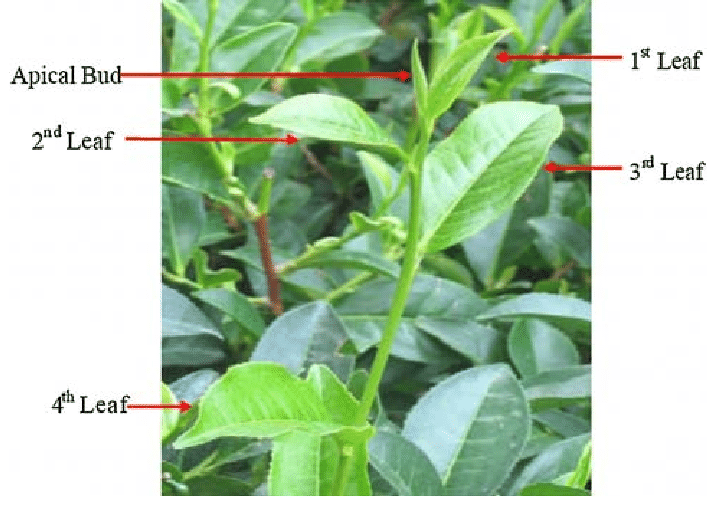Grading
Grading is based on the “size” of the individual leaves and flushes, which is determined by their ability to fall through the screens of special meshesranging from 8–30 mesh. This also determines the “wholeness”, or level of breakage, of each leaf, which is also part of the grading system. Although these are not the only factors used to determine quality, the size and wholeness of the leaves will have the greatest influence on the taste, clarity, and brewing time of the tea.
- Choppy: contains many leaves of various sizes.
- Fannings: are small particles of tea leaves used almost exclusively in tea bags.
- Flowery: consists of large leaves, typically plucked in the second or third flush with an abundance of tips. (Medium quaity).
- Golden Flowery: includes very young tips or buds (usually golden in colour) that were picked early in the season. (high quaity).
- Tippy: includes an abundance of tips (highest quaity).

a.) Teas that receive the highest grades are obtained from new flushes (pickings).This includes the terminal leaf bud along with a few of the youngest leaves. The term “pekoe” (or, occasionally, orange pekoe) describes the unopened terminal leaf bud (tips) in tea flushes. orange pekoe generally used in Green leaf and black tea’s. As such, the phrases “a bud and a leaf” or “a bud and two leaves” are used to describe the “leafiness” of a flush; they are also used interchangeably with pekoe and a leaf or pekoe and two leaves. Top-quality pekoe grades consist of only the leaf buds, which are picked using the balls of the fingertips. Fingernails and mechanical tools are not used, to avoid bruising.


b.) Fannings are small pieces of tea that are left over after higher grades of teas are gathered to be sold. Traditionally these were treated as the rejects of the manufacturing process in making high-quality leaf tea like the orange pekoe.
c.) Fannings with extremely small particles are sometimes called dusts. Fannings and dusts are considered the lowest grades of tea, separated from broken-leaf teas which have larger pieces of the leaves.
However, the fannings of expensive teas can still be more expensive and more flavourful than whole leaves of cheaper teas. This traditionally low-quality tea has, however, experienced a huge demand in the developing world in the last century as the practice of tea drinking became popular. Because of the small size of the particles, a tea infuser is typically used to brew fannings. Fannings are also typically used in most tea bags, although some companies sell tea bags containing whole-leaf tea. Some exporters focus primarily on broken-leaf teas, fannings, and dusts.
